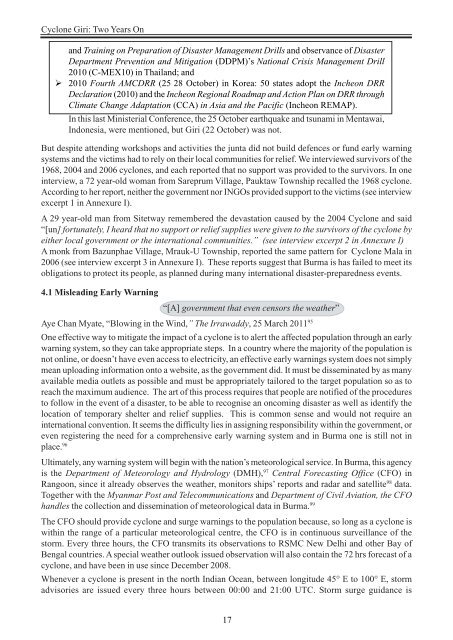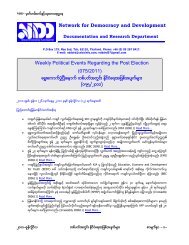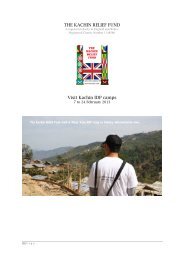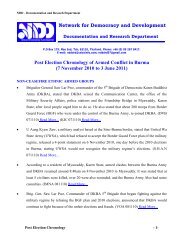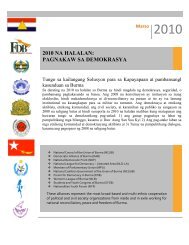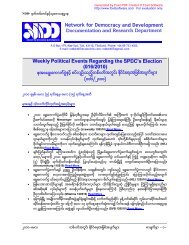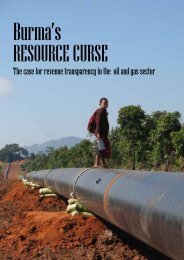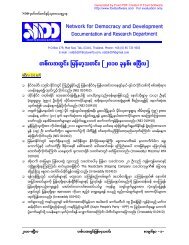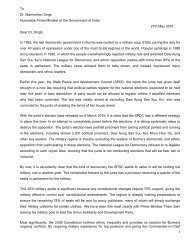Cyclone Giri - Two Years On - Burma Action Ireland
Cyclone Giri - Two Years On - Burma Action Ireland
Cyclone Giri - Two Years On - Burma Action Ireland
Create successful ePaper yourself
Turn your PDF publications into a flip-book with our unique Google optimized e-Paper software.
<strong>Cyclone</strong> <strong>Giri</strong>: <strong>Two</strong> <strong>Years</strong> <strong>On</strong><br />
and Training on Preparation of Disaster Management Drills and observance of Disaster<br />
Department Prevention and Mitigation (DDPM)’s National Crisis Management Drill<br />
2010 (C-MEX10) in Thailand; and<br />
2010 Fourth AMCDRR (25 28 October) in Korea: 50 states adopt the Incheon DRR<br />
Declaration (2010) and the Incheon Regional Roadmap and <strong>Action</strong> Plan on DRR through<br />
Climate Change Adaptation (CCA) in Asia and the Pacific (Incheon REMAP).<br />
In this last Ministerial Conference, the 25 October earthquake and tsunami in Mentawai,<br />
Indonesia, were mentioned, but <strong>Giri</strong> (22 October) was not.<br />
But despite attending workshops and activities the junta did not build defences or fund early warning<br />
systems and the victims had to rely on their local communities for relief. We interviewed survivors of the<br />
1968, 2004 and 2006 cyclones, and each reported that no support was provided to the survivors. In one<br />
interview, a 72 year-old woman from Sareprum Village, Pauktaw Township recalled the 1968 cyclone.<br />
According to her report, neither the government nor INGOs provided support to the victims (see interview<br />
excerpt 1 in Annexure I).<br />
A 29 year-old man from Sitetway remembered the devastation caused by the 2004 <strong>Cyclone</strong> and said<br />
“[un] fortunately, I heard that no support or relief supplies were given to the survivors of the cyclone by<br />
either local government or the international communities.” (see interview excerpt 2 in Annexure I)<br />
A monk from Bazunphae Village, Mrauk-U Township, reported the same pattern for <strong>Cyclone</strong> Mala in<br />
2006 (see interview excerpt 3 in Annexure I). These reports suggest that <strong>Burma</strong> is has failed to meet its<br />
obligations to protect its people, as planned during many international disaster-preparedness events.<br />
4.1 Misleading Early Warning<br />
“[A] government that even censors the weather”<br />
Aye Chan Myate, “Blowing in the Wind,” The Irrawaddy, 25 March 2011 95<br />
<strong>On</strong>e effective way to mitigate the impact of a cyclone is to alert the affected population through an early<br />
warning system, so they can take appropriate steps. In a country where the majority of the population is<br />
not online, or doesn’t have even access to electricity, an effective early warnings system does not simply<br />
mean uploading information onto a website, as the government did. It must be disseminated by as many<br />
available media outlets as possible and must be appropriately tailored to the target population so as to<br />
reach the maximum audience. The art of this process requires that people are notified of the procedures<br />
to follow in the event of a disaster, to be able to recognise an oncoming disaster as well as identify the<br />
location of temporary shelter and relief supplies. This is common sense and would not require an<br />
international convention. It seems the difficulty lies in assigning responsibility within the government, or<br />
even registering the need for a comprehensive early warning system and in <strong>Burma</strong> one is still not in<br />
place. 96<br />
Ultimately, any warning system will begin with the nation’s meteorological service. In <strong>Burma</strong>, this agency<br />
is the Department of Meteorology and Hydrology (DMH), 97 Central Forecasting Office (CFO) in<br />
Rangoon, since it already observes the weather, monitors ships’ reports and radar and satellite 98 data.<br />
Together with the Myanmar Post and Telecommunications and Department of Civil Aviation, the CFO<br />
handles the collection and dissemination of meteorological data in <strong>Burma</strong>. 99<br />
The CFO should provide cyclone and surge warnings to the population because, so long as a cyclone is<br />
within the range of a particular meteorological centre, the CFO is in continuous surveillance of the<br />
storm. Every three hours, the CFO transmits its observations to RSMC New Delhi and other Bay of<br />
Bengal countries. A special weather outlook issued observation will also contain the 72 hrs forecast of a<br />
cyclone, and have been in use since December 2008.<br />
Whenever a cyclone is present in the north Indian Ocean, between longitude 45° E to 100° E, storm<br />
advisories are issued every three hours between 00:00 and 21:00 UTC. Storm surge guidance is<br />
17


